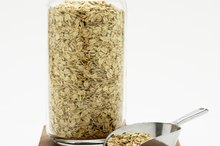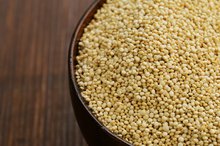Signs & Symptoms of Wheat & Whole Grain Allergies
The Food Allergy and Anaphylactic Network states that most wheat and grain allergies are experienced in childhood and outgrown by adulthood. A wheat allergy can occur at any age and needs to be evaluated and diagnosed by a medical doctor. Wheat allergies cannot be diagnosed based exclusively on symptoms because other conditions, such as celiac disease and gluten intolerance may cause similar symptoms. If you’re diagnosed with a wheat allergy, you are at a higher risk of having an allergy to another grain. Signs and symptoms commonly develop within a few minutes after consuming the grain.
Severe Reactions
Although rare, a wheat and whole grain allergy can cause a severe allergic reaction, or anaphylaxis. Anaphylaxis is an allergic reaction that affects the entire body and can be life-threatening. Common signs and symptoms, according to MedlinePlus include confusion, anxiety, abdominal pain, wheezing, coughing, diarrhea, bluish-colored skin, hives, facial swelling, slurred speech and lightheadedness. This condition may require emergency medical attention. Call 911 at the first sign of these symptoms to avoid further complications.
- Although rare, a wheat and whole grain allergy can cause a severe allergic reaction, or anaphylaxis.
Nasal Complications
Wheat Grain & Eczema
Learn More
A wheat allergy can cause nasal complications, including a runny nose, sneezing, congestion and postnasal drip. Certain chemicals involved in an allergic reaction can cause your sinus cavity to swell, cutting off your ability to breathe and expel mucus thorough your nostrils. Swollen sinuses will cause sinus pressure that can develop into a sinus headache, causing pain in the forehead, teeth, and cheeks and behind the eyes. Postnasal drip is the constant dripping of mucus in the back of your throat that can cause bad breath, a sore throat or coughing.
- A wheat allergy can cause nasal complications, including a runny nose, sneezing, congestion and postnasal drip.
- Swollen sinuses will cause sinus pressure that can develop into a sinus headache, causing pain in the forehead, teeth, and cheeks and behind the eyes.
Digestive Issues
Shortly after eating wheat or other grains you may develop digestive issues. Your intestines can become irritated and inflamed from an allergic reaction, leading to stomach pain, cramping, bloating, gas, vomiting, nausea and diarrhea. Digestive issues should not last for more than a day. If you experience severe diarrhea or vomiting, call your doctor. You may become dehydrated if you develop these symptoms.
- Shortly after eating wheat or other grains you may develop digestive issues.
Skin Reactions
Symptoms of Allergies to Chickpeas and Soy
Learn More
The skin can react after eating grains or wheat if you’re allergic. You may feel tingling in your mouth, tongue or lips or various parts of your face can swell from an allergic reaction. Common skin reactions associated with a wheat and grain allergy are hives and eczema. Both skin conditions are very itchy and cause the skin to become inflamed.
- The skin can react after eating grains or wheat if you’re allergic.
Related Articles
References
- MayoClinic.com: Wheat Allergy
- MedlinePlus: Anaphylaxis
- Cianferoni A. Wheat allergy: diagnosis and management. J Asthma Allergy. 2016;9:13-25. doi:10.2147/JAA.S81550
- Salcedo G, Quirce S, Diaz-perales A. Wheat allergens associated with Baker's asthma. J Investig Allergol Clin Immunol. 2011;21(2):81-92.
- Scherf KA, Brockow K, Biedermann T, Koehler P, Wieser H. Wheat-dependent exercise-induced anaphylaxis. Clin Exp Allergy. 2016;46(1):10-20. doi:10.1111/cea.12640
- Pacharn P, Vichyanond P. Immunotherapy for IgE-mediated wheat allergy. Hum Vaccin Immunother. 2017;13(10):2462-2466. doi:10.1080/21645515.2017.1356499
- Czaja-Bulsa G, Bulsa M.What Do We Know Now about IgE-Mediated Wheat Allergy in Children?Nutrients. 2017 Jan 4;9(1). pii: E35. doi: 10.3390/nu9010035.
- Pacharn P, Vichyanond P.Immunotherapy for IgE-mediated wheat allergy.Hum Vaccin Immunother. 2017 Oct 3;13(10):2462-2466. doi: 10.1080/21645515.2017.1356499.
Writer Bio
Diane Marks started her writing career in 2010 and has been in health care administration for more than 30 years. She holds a registered nurse license from Citizens General Hospital School of Nursing, a Bachelor of Arts in health care education from California University of Pennsylvania and a Master of Science in health administration from the University of Pittsburgh.









